Author: Michelin
2023 has just passed more than two months, and the competition in the automotive industry has entered a state of intense heat. This year’s price war has reached its peak, with recent prices dropping sharply under the influence of Dongfeng.
On one side, the joint venture brands have lowered their prices, regardless of the subsequent turmoil; on the other side, the independent brands tightly hold the tickets for the second half of hybrid technology, upgrading their own hybrid technology. In just the past two weeks, I have participated in three independent brand hybrid technology conferences: Geely’s “Goddess of Thunder” electric-hybrid 8848 system, Chery’s Mars architecture – super hybrid platform, and the newly launched intelligent four-wheel drive hybrid technology Hi4 of Great Wall Motors tonight.
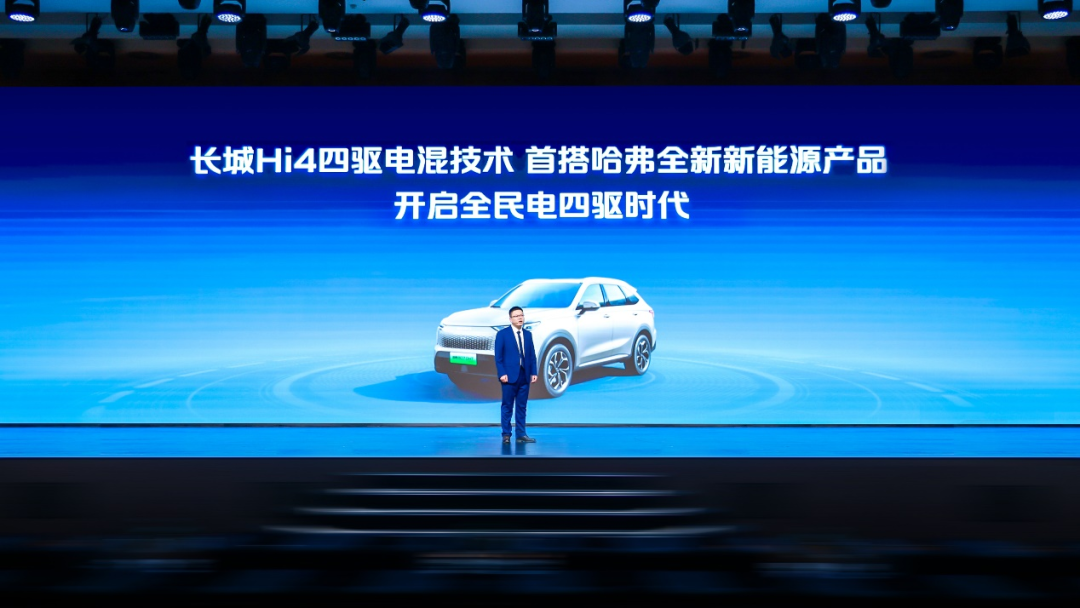
If last month’s launch of the BYD Qin Plus DM-i was equalizing the price of hybrid models, then Great Wall’s launch of the all-new Hi4 is equalizing the technology in terms of performance, replacing the price and energy consumption of the two-wheel drive with the performance experience of the four-wheel drive.
I don’t know if Great Wall’s “hybrid equality” this time can win the hearts of users?
How to make hybrid technology more equal?
Just past 2022, the sales of domestic plug-in hybrid models reached 1.518 million units, a year-on-year increase of 151.6%. If someone still says that domestic hybrid technology is not good in 2023, the more than 1.5 million consumers who voted with their wallets last year may be the first to disagree.
Nowadays, when consumers buy a hybrid model, they no longer have to compromise, but it seems that they are still far from the moment of happiness where they “want both and want more”: if they want fuel economy, save oil and electricity, the power of front-wheel drive is sometimes not enough; if they want the experience of four-wheel drive, the fuel and electricity consumption is not so good… Performance, energy consumption, and price constitute the “impossible triangle” of hybrid technology.
Creating a system with the performance and experience of four-wheel drive and the price and energy consumption of two-wheel drive has become the key to hybrid equality.
The first step to hybrid equality: dual motors for four-wheel drive
At present, the structures of various hybrid technologies in the industry are divided into series-parallel, series-parallel-parallel, and planetary gear systems. Regardless of the specific technical details, although different layouts and technologies are adopted by various companies, they all have the same goal: to optimize the energy chain by arranging and combining engines, motors, gearboxes, and batteries with the highest efficiency.This is because both the engine and motor have their own optimal working range—the efficient zone. Taking the engine as an example, the highest thermal efficiency is achieved when the engine is at 2000 rpm and 120N·m. However, when the speed drops below 1500 rpm, the thermal efficiency of the engine decreases significantly.

Therefore, in the past, hybrid systems usually equipped the front axle with two motors, one mainly for power generation and the other mainly for driving. This way, when the vehicle is driving at low speed, the front driving motor and the engine are decoupled, and the engine can still work in the efficient zone. With the adoption of a dual-motor hybrid system, it is usually a front-wheel drive two-wheel drive mode. To achieve four-wheel drive, a fully battery-driven rear driving motor needs to be added to the rear axle, which is currently a commonly used three-motor four-wheel drive hybrid structure.
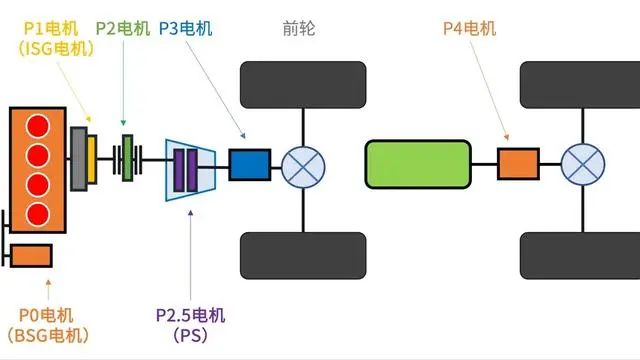
Taking BYD DM-p as an example, it is equipped with three motors: P0 BSG motor, P3 front axle motor, and P4 rear axle motor.

Although this achieves a balance between power and fuel economy, the cost of the three-motor structure itself and the two-wheel drive mode that is only activated during high-speed cruising, to some extent, determine the cost and price of the DM-p product. In fact, compared with the DM-i model, the same model DM-p is priced about 50,000 yuan higher.
In order to achieve four-wheel drive through a dual-motor system, the brand new Hi4 eliminates the P0 BSG motor and designs a two-speed gearbox at the engine output end. In this way, when the engine is in the high-speed range, it can be transmitted to the front axle at a relatively low speed through the two-speed gearbox. The rear driving motor still adopts pure electric drive. The total power of the rear driving module assembly motor reaches 150kW, and the motor efficiency is as high as 96.5%, and the whole vehicle power reaches 340kW.
This new configuration of a dual-motor series-parallel four-wheel drive system with front and back axes replaces the previous three-motor structure, reducing mechanical complexity and costs while achieving a nearly perfect 50:50 axle load distribution for higher overall vehicle performance.
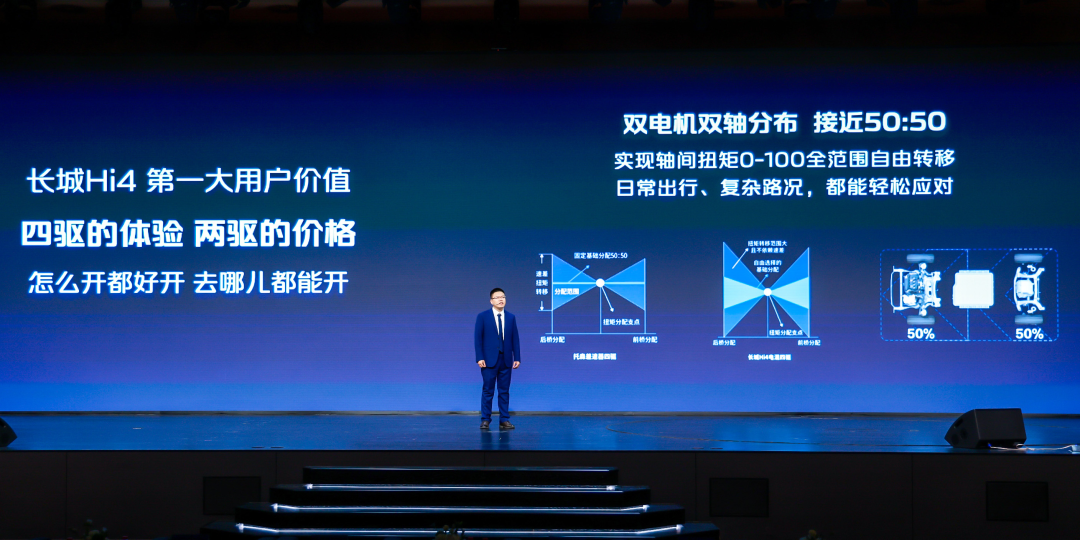
Hybrid power equalization step two: Two-speed DHT enables direct drive at low speeds
As we learned in junior high school physics, the shorter the energy transmission path, the less energy is lost in transmission. For example, directly driving the engine output end is more efficient than driving it through the various mechanical structures of the transmission and clutch.
However, as previously mentioned, the engine’s narrow high-efficiency zone restricts direct-drive mode to speeds of 60-120 km/h, and the engine’s efficiency decreases significantly during most low-speed city driving. The startup of the extended range mode at low speeds leads to a long energy transmission path from the engine-generator-battery to the drive motor, reducing efficiency.
To fully utilize the engine’s narrow high-efficiency zone, the new Hi4 technology uses a two-speed DHT transmission directly linked to the engine output end. By leveraging the two gear ratios, the high-efficiency zone is expanded, resulting in improved fuel economy for direct drive at speeds over 40 km/h.
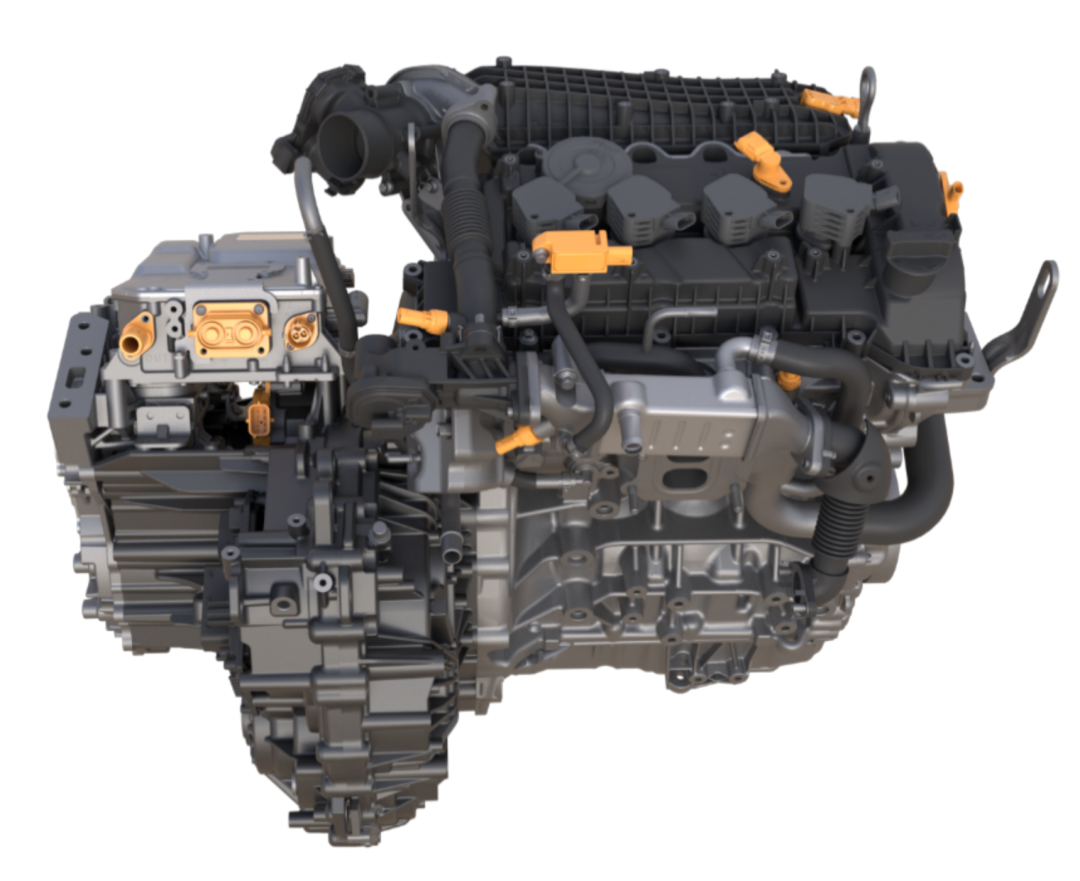
Correspondingly, the new Hi4 contains two sets of powertrain systems, which consist of two hybrid-specific engines (1.5L/1.5T) with a thermal efficiency of 41.5%, resulting in a 6%-7% reduction in fuel consumption, and the new Hi4 front-wheel-drive module assembly, which has a transmission efficiency of up to 98%. Gear changes are seamless without any jerks, and both power and comfort are improved.
Step Three of Hybrid Equalization: Optimal Solution Under All Conditions
Pure electric mode saves energy when driving in daily urban areas, but loses power when driving at high speeds;
Range Extender mode is efficient while cruising at high speeds, but inefficient at low speeds;
Two-wheel drive mode is sufficient for daily use, but lacks power when climbing, overtaking or off-road driving;
……
This is the real feeling of many people when driving daily. Making a system obedient, considerate, and capable of meeting the needs under different conditions in real-time not only requires mechanical structures and hardware, but also intelligent control systems.
Great Wall Motors equipped the new Hi4 with the iTVC intelligent torque distribution system, which accurately identifies road conditions in real-time and adjusts the states of the front and rear dual motors and hybrid-specific engines, enabling them to operate in the most economical mode while ensuring power needs.
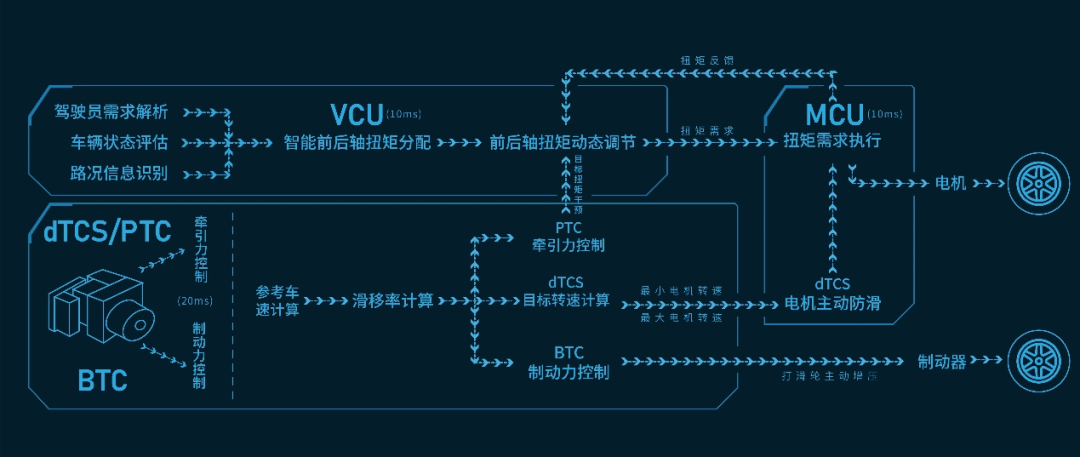
According to different road conditions and power needs, it is divided into 9 modes. For example, in urban driving, the pure electric mode is activated; when accelerating, climbing or in a state of power loss in urban areas, the 1st gear direct drive and front-wheel drive can meet economic needs; when cruising at high speeds, which is the weak point of pure electric mode, it automatically switches to 2nd gear direct drive, which is more efficient and powerful; when there is a four-wheel drive requirement, pure electric/parallel four-wheel drive mode is activated, which is more powerful.

Finally
At the end of last year, Great Wall Motors carried out a structural reorganization, “subtracting” in terms of brand and sales systems, and “adding” in terms of technology research and development and the ecological chain. At this “practical conference”, the effect of addition and subtraction has emerged.
The new intelligent four-wheel drive hybrid technology, Hi4, released this time is the result of the joint cooperation among Great Wall Motors, forest ecology and other enterprises. Next month, the first Hafer hybrid vehicle equipped with the new Hi4 will be unveiled, and this year’s new DHT technology will also be fully used in Wei brand and Haver, covering various price ranges. The new Hi4 is not only a weapon for Great Wall Motors to compete with independent brand hybrid technology, but also a sharp tool for its own product fully electrification transformation.And the forest ecological layout of the Great Wall is not only on hybrid technology. In the field of power, Great Wall Motors has laid out three tracks in parallel: hybrid, pure electric, and hydrogen energy. In terms of intelligence, it has wired control steering, wired control braking, intelligent cockpit technology, and full-range self-developed capabilities from perception hardware to computing platforms for intelligent driving. Even in the energy field, Great Wall Motors has also constructed an energy system of “photovoltaic + distributed storage + centralized storage.” This series of investments has made Great Wall Motors an enterprise with a full industry chain layout, firmly grasping core technologies in its own hands.
After all, in the second half of the future competition, it is not only the competition of intelligent electric vehicles, but also the competition of technology supremacy.

This article is a translation by ChatGPT of a Chinese report from 42HOW. If you have any questions about it, please email bd@42how.com.
